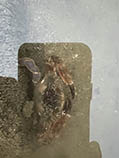Charybdis hellerii (Milne-Edwards, 1867)
Spiny handsWarning: DOMDocument::load(): SSL operation failed with code 1. OpenSSL Error messages: error:140770FC:SSL routines:SSL23_GET_SERVER_HELLO:unknown protocol in C:\Apache24\htdocs\includes\SpeciesSummary.lib.php on line 1236
Warning: DOMDocument::load(): Failed to enable crypto in C:\Apache24\htdocs\includes\SpeciesSummary.lib.php on line 1236
Warning: DOMDocument::load(https://sealifebase.nrm.se/webservice/AquaMaps/getAMap.php?genus=Charybdis&species=hellerii): failed to open stream: operation failed in C:\Apache24\htdocs\includes\SpeciesSummary.lib.php on line 1236
Warning: DOMDocument::load(): I/O warning : failed to load external entity "https://sealifebase.nrm.se/webservice/AquaMaps/getAMap.php?genus=Charybdis&species=hellerii" in C:\Apache24\htdocs\includes\SpeciesSummary.lib.php on line 1236
Classification / Names Common names | Synonyms | CoL | ITIS | WoRMS
Malacostraca | Decapoda | Portunidae
Environment: milieu / climate zone / depth range / distribution range Ecology
Benthopelagic; brackish; depth range 0 - 51 m (Ref. 74519), usually 0 - 30 m (Ref. 106819). Tropical; 30°N - 31°S, 29°E - 154°W
Distribution Countries | FAO areas | Ecosystems | Occurrences | Introductions
Indo-Pacific. Introduced in the Atlantic and the Mediterranean Sea. Subtropical to tropical.
Length at first maturity / Size / Weight / Age
Maturity: Lm ?, range 4 - ? cm Max length : 7.9 cm CW male/unsexed; (Ref. 77880); 7.7 cm CW (female); common length : 4.7 cm CW male/unsexed; (Ref. 93549); max. reported age: 3.00 years (Ref. 108232)
Pref min-pref max estimated. Assumed common length range: 3.62 to 4.7 cm CW (Ref. 93549). Benthopelagic (Ref. 97531). Prefers soft bottoms (Ref. 103831), with sandy to muddy substrates (Ref. 106287). Found on rocky coast and on coral reefs (Ref. 121712). Intertidal, found under rocks and stones and among live corals (Ref. 95903); also on rubble (Ref. 97531). Also found in an estuary-bay complex (Ref. 121721) as well as on the roots of the mangrove Rhizophora mangle (Ref. 103831) and the seagrass Halophila stipulacea (Ref. 119437).
Life cycle and mating behavior Maturity | Reproduction | Spawning | Eggs | Fecundity | Larvae
Mating behavior: Precopulatory courtship ritual is common (through olfactory and tactile cues); usually indirect sperm transfer (Ref. 833).
Main reference
References | Coordinator | Collaborators
Benson, A.J., P.L. Fuller and C.C. Jacono. 2001. (Ref. 8125)
IUCN Red List Status (Ref. 130435)
CITES status (Ref. 108899)
Not Evaluated
CMS (Ref. 116361)
Not Evaluated
Threat to humans
Human uses
Fisheries: commercial
| FishSource |
Tools
More information
Internet sources
BHL | BOLD Systems | CISTI | DiscoverLife | FAO(Publication : search) | Fishipedia | GenBank (genome, nucleotide) | GloBI | Gomexsi | Google Books | Google Scholar | Google | PubMed | Tree of Life | Wikipedia (Go, Search) | Zoological Record
Estimates based on models
Preferred temperature
(Ref. 115969): 24.6 - 29, mean 28 (based on 1914 cells).
Price category
(Ref. 80766):
Unknown.



